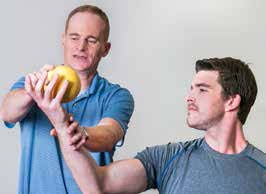
Rotator cuff tears, a common injury, send as many as 2 million Americans to their physicians’ offices every year. While many cases can be treated with conservative measures, such as physical therapy, others require rotator cuff repair surgery. One factor affecting surgery outcome is the presence of fat in place of muscle, a condition that often makes surgery less successful. Even if that is the case, however, a good rehabilitation regimen can help maximize your recovery.
The ball at the top of the upper arm is kept in place by a system of muscles and tendons that come together to form the rotator cuff. A fall can cause an acute tear of the rotator cuff, while repetitive stress, bone spurs or a lack of blood supply can cause a chronic degenerative tear.
In about half the patients with rotator cuff tears, rest, strengthening exercises, physical therapy and other nonsurgical treatments will relieve pain and improve shoulder function. For larger tears and for pain lasting more than six months, your physician may recommend surgery. In some of these more serious cases, muscles have atrophied and no longer attach to the bone; even worse, fat may have replaced some of the atrophied muscle. The presence of this substance, referred to as fatty infiltrate, can be confirmed with magnetic resonance imaging.
Patients with fatty infiltrate in the rotator cuff have poorer outcomes after surgery because, among other reasons, the loss of muscle is irreversible. In some cases, if the physician finds that surgery will not help, other treatments, including training the deltoid muscle to take over the work of the shoulder, might be successful.
Regardless of which course of treatment your physician recommends, physical therapy is an important component of recovery from a torn rotator cuff. We will work with you and your physician—either in place of or after surgery—to strengthen your muscles and improve your shoulder strength and range of motion.
Rotator cuff surgery usually requires four to six months for primary recovery. Whether your surgery goes smoothly or is complicated by fatty infiltrate, sticking with the rehabilitation program we design for you is the key to a successful outcome.
